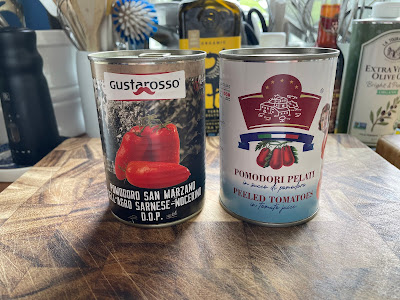 |
| Salvatore Ricotta |
The best ricotta I ever had was from Salvatore Brooklyn. I once went to a Williams-Sonoma store in NYC to see a demonstration by Betsy Devine of how she makes it at Salvatore, and that was when I decided I would be able to make my own. You can see the thick texture, which is what I was - and am - aiming for.
The recipe I use is adapted from J. Kenji Lopez-Alt's recipe in his seminal work, The Food Lab, but there are other good recipes for you to check out - FOOD52 and Smitten Kitchen, who also likes Salvatore. If you don't have or use a microwave, Jennifer Perillo's recipe on FOOD52 is the way to go. It is the first recipe I tried so I know it works!
I often use 3 cups whole milk and 1 cup heavy cream unless I want to make it extremely rich in which case I use 2 cups whole milk and 2 cups heavy cream.
I put my 4 cups of dairy in a 4-cup Pyrex measuring cup. I add 1/2 teaspoon salt, either kosher or Italian fine sea salt, and 1/4 cup distilled white vinegar. Kenji says you can add the same amount of lemon juice; however, since the white vinegar is consistently 5 per cent acid, I find it unfailingly reliable so that is what I use.
I heat the milk and cream mixture in the microwave until the temperature reaches 165°F on an instant-read thermometer. In my microwave, which is small, this takes about 8 minutes.
At this point, I remove the cup from the microwave and stir it gently for about 5 seconds. It is already separating into curds and whey.
I transfer to a fine sieve that I have lined with a white mesh vegetable bag. It can certainly be lined with cheesecloth.
I cover the top with plastic wrap and let it reach the desired consistency. The more it drains, the "dryer" it will be.
 |
| My Ricotta |
You can see the texture. It's almost like ice cream. Since I am usually using this to make manicotti, it gets thinner with the addition of eggs so this is a perfect texture for me to start with.
I use a 4-cup Pyrex measuring cup for this.
To 3 cups whole milk and 1 cup heavy cream or 2 cups whole milk and 2 cups heavy cream if you want it to be very rich, add 1/2 teaspoon salt, kosher or (for me Italian) sea salt and 1/4 cup distilled white vinegar.
I heat the milk and cream mixture in the microwave until the temperature reaches 165°F on an instant-read thermometer. In my microwave, which is small, this takes about 8 minutes. You can certainly do this on top of the stove.
At this point, stir it gently for about 5 seconds. It should already be separating into curds and whey.
Transfer to a fine sieve lined with a white mesh vegetable bag or cheesecloth.
Cover the top with plastic wrap and let it reach the desired consistency. The more it drains, the "dryer" it will be.





